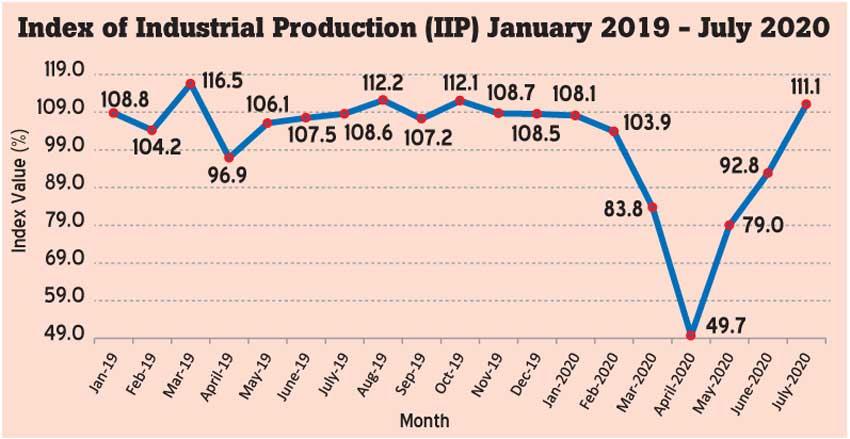15 Sep 2020 - {{hitsCtrl.values.hits}}

Sri Lanka’s manufacturing sector is ploughing ahead, beating the odds of the pandemic-induced disruptions, as the Index of Industrial Production (IIP) has reached pre-pandemic levels in July, with major manufacturing activities advancing ahead despite a few still lagging.
According to the data released by the Census and Statistics Department, the IIP, which measures the total volume of goods and services, reached 111.1 index points in July, eclipsing the 108.6 index points in the same month in 2019, pointing to a continued expansion in the country’s production activities in key sectors.
The index, which hit a nadir in April, due to the shutdown of factories and other production facilities around the country, barring a few in the essential and export-oriented sectors, began its climb starting from May, signalling that manufacturing activities were fast returning to their normalcy, with the easing of the restrictions of movement of people and conducting of businesses.
This was also evident from the Purchasing Mangers’ Index (PMI) for the three months from May through July, which pointed to a sharp expansion of both manufacturing and services activities. Merchandise exports for the same period also supported the faster rebound in the manufacturing sector in the country.
However, unlike the PMI, the IIP demonstrates a detailed breakdown of activities and how they have changed their volumes in the short term. A closer look at the major seven manufacturing sectors showed, all but wearing apparel, coke and refined petroleum products and rubber and plastic products, have recorded gains during July, compared to the same month in 2019.
Wearing apparel manufacturing, Sri Lanka’s largest manufacturing industry, although rebounded faster, with transforming its manufacturing to personal protective equipment (PPE), is reeling from the still dampened order book for their regular apparel types, as extended stay-at-home orders, remote working and limited brick-and-mortar retailing in Sri Lanka’s export market, have triggered less than normal demand for regular garments. This was reflected in the decline in wearing apparels by 17.2 percent to 93.8 points in July, over the same month, last year but textile manufacturing had gained by 7.5 percent to 134.1 points.
Meanwhile, production of food items gained by 13.7 percent to 117.5 index points, while beverages advanced the most by 32.4 percent to 123.9 points, reflecting the ramped up domestic food and beverage production in the aftermath of the pandemic, for both food security as well as for the export market.
Further, chemical and chemical products gained 16.6 percent to 120.1 index points and other non-metallic mineral products gained 3.0 percent to 131.9 points.
Another notable area in the IIP is manufacturing of basic pharmaceutical products and pharmaceutical preparations, which advanced by 12.9 percent to 122.6 index points, during July, over the same month in 2019. This indicates that domestic production of medicinal drugs has gained some momentum during and in the immediate aftermath of the pandemic.
Last week, the government devised plans to manufacture half of the medicinal drug requirement domestically within the next three years and it allocated 400 acres in the Hambantota industrial zone for export-oriented pharmaceutical manufacturers and another 100 acre plot of land in Oyamaduwa, in Anuradhapura, for local investors in the drugs manufacturing sector.
18 Nov 2024 25 minute ago
18 Nov 2024 4 hours ago
18 Nov 2024 5 hours ago
18 Nov 2024 5 hours ago
18 Nov 2024 5 hours ago